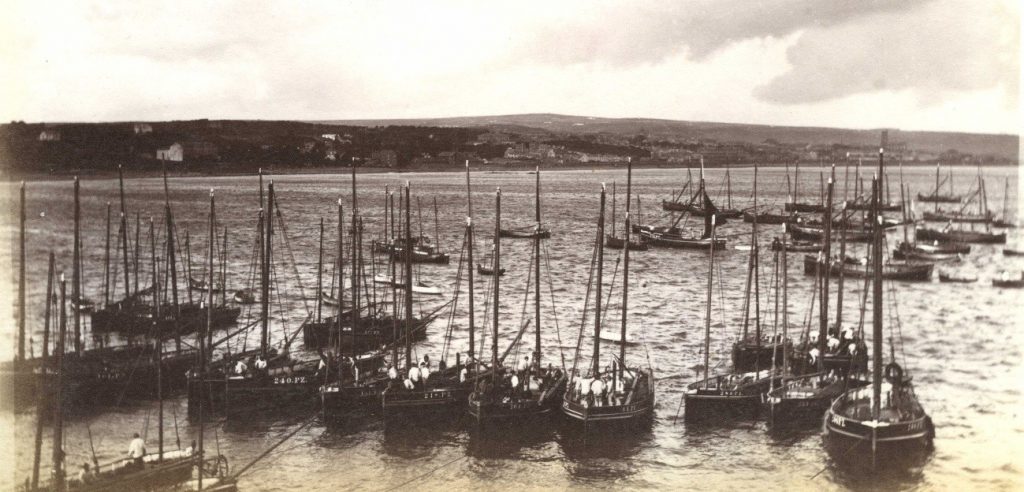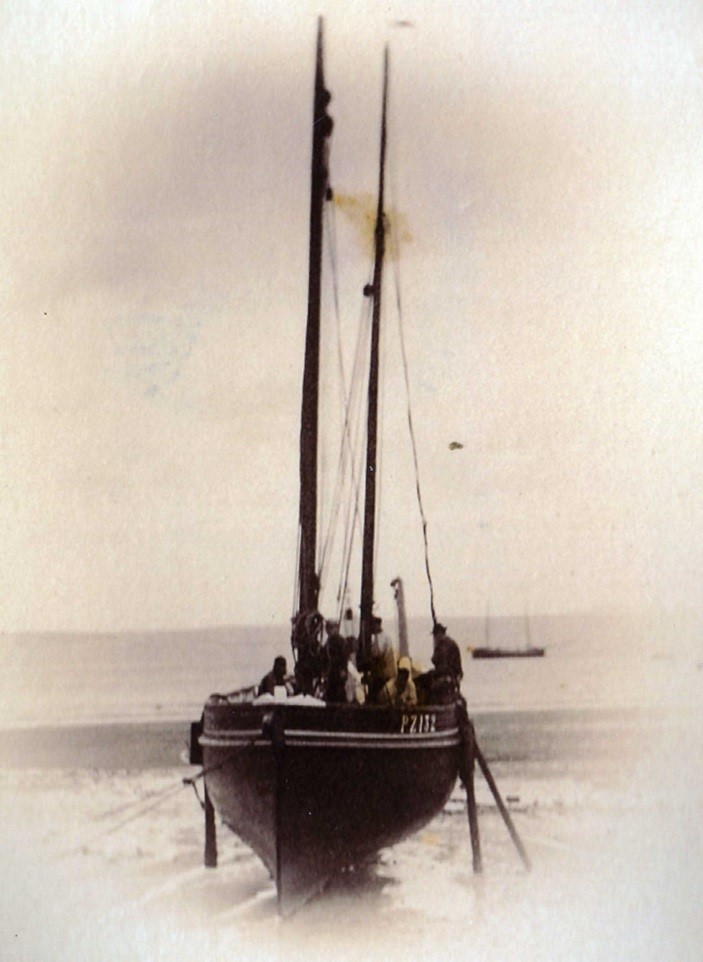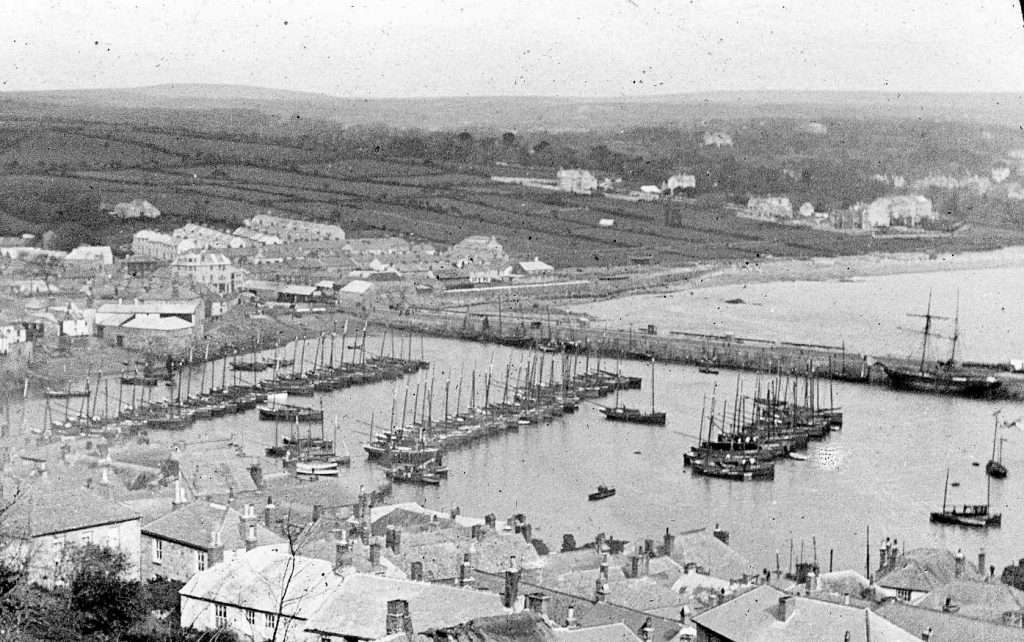Pz.28 Ada
27 August 2019PZ.486 Auld-Lang-Syne
28 August 2019Swan 132.PZ : >1869-1887; Swan PZ.132: 1887-1895
The Swan was one of the immense fleet of Mount’s Bay luggers in existence before the introduction of the general registration of British Sea Fishing Boats in 1869. As such we do not know when she was actually built, but she was registered at Penzance Custom House on March 8th 1869. Although one of the bigger luggers of the period, because she measured less than 15 tons, with a keel length of 40 feet, she was classed as a 2nd Class lugger, and as such was allocated the fishing registration number 132.PZ.1 Owned by Philip Pearce of Newlyn, she was skippered by his son, Philip (the younger), and they worked her for the next 18 years.
Then, in October 1887 she was acquired by Boot & Shoe maker James Guy, one of the few Newlyn boat owners who acquired a number of boats over the years as an investment.2 He does not appear to have ever gone fishing himself, appointing Francis Richards as her skipper. New tonnage measurement rules had been introduced in the 1880s, and like many other boats of her size, when the Swan was re-measured on James Guy acquisition, she was found to be of 16.75-tons measurement, bringing her above the 15-ton limit, making her a First Class boat. With an overall length of 43.7 feet, her fishing number was amended to PZ.132.3
At this time the new harbour at Newlyn was still under construction, with the North Pier only half its designed length, leaving a wide open harbour mouth, partly protected by the South Pier.

About the time of the above photograph of luggers at their moorings, the Swan was re-registered, and shortly afterwards she was photographed, dried out on the beach under the Cliff, Newlyn.

[Penlee House Museum : PEZPH 1993:45:51]
Sharp hulled, with a steep rise of floors, the Swan needed ‘legs’ to keep her upright when aground. Probably photographed on a Saturday afternoon, and her crew are tidying up the boat for the weekend, and preparing for the next week’s fishing.
Within a few years, in June 1893 the lugger was being offered for sale.

However, it was more than a year later, before a new owner of the Swan was registered, when she became property of Samuel Payne, in September 1894. Payne, who was an owner-skipper, employed her mainly in the inshore trawl fishery, and occasionally in the hook and line fishery, but his ownership was short-lived.
Between 1894 and 1914, the head of the South Pier of Newlyn harbour lay directly in line with the line of the North Pier. This left the mouth of the harbour partially open to south-easterly gales. With the result that Newlyn harbour was not a very safe haven when those conditions prevailed. At such times a powerful run of sea could surge up and down the North pier, and up the harbour, which lead to the practice of mooring the luggers in tiers, away from the quay side, with their bows seawards, to breast the run.

[Tony Pawlyn collection: unattributed.]
During the second week of January 1895 a particularly heavy south-easterly gale raged across Mount’s Bay during the early hours of the Saturday. On the Monday a Plymouth daily paper published a full account of the damage caused by what they described as ‘a perfect hurricane.’
THE FISHING FLEET AT NEWLYN.
The wind at Newlyn was from south-east, and by three o’clock on Saturday morning a mountainous sea was running, and one of the severest gales of the winter was blowing. The new piers and harbour were subjected to the severest test they have yet had, and came out of the ordeal most satisfactorily. …
… At about six in the morning the Swan, local trawler, belonging to Mr. Samuel Payne, broke adrift and came ashore, as also did the small liner Louise, Messrs. Vingo; the Pickwick, trawler, of Brixham; and the Rosalind, liner, Messrs. Johns, of Mousehole. The Louise sustained a great deal of damage to top sides, and was holed on the starboard side. The Swan was also badly damaged, but the Rosalind and Pickwick came off scathless. These four craft were thrown on the bank. …
… On Sunday morning at six o’clock the Pickwick was got afloat, and the damage to the Louise and Swan was found to be so serious as to be irreparable.
Western Morning News, January 14th, 1895
One of the Penzance weekly papers gave a slightly different account of the gale damage:
The Swan belonging to Mr. Samuel Payne, of Newlyn, had been moored alongside the eastern pier [known as the North Pier], but broke away and washed upon the beach in a line with Mr. Carter’s grocer’s store, at Street-an-nowan, and had a plank smashed.
The Swan had some bad holes knocked in her and as the tide returned filled with water.
The Louise was broken up for firewood on the beach; and it is probable that the Swan will share the same fate, though she is a better boat and hardly damaged as much as the Louise.
NEWLYN.
The Swan, which was thrown ashore at Newlyn on Saturday, is one of our most antiquated crafts, being over 30 years old. The beating on the beach in Saturday’s breeze has undoubtedly sealed her doom, and she will no longer swim the waters like the graceful bird after which she is named.
Cornishman, Thursday, January 17th, 1895
Damaged beyond economic repair, the Swan’s registration as a sea fishing boat was cancelled on February 25th 1895.
Unfortunately that was not quite the end of the sorry story in so far as her owner Samuel Payne was concerned – her loss put him in financial straits, and in April 1897, he became bankrupt.
FAILURE OF A NEWLYN FISHERMAN. – A first meeting of creditors of Samuel Payne, fisherman, of 13, Alverne-buildings, Penzance, was held at the office of the official receiver (Mr. G. Appleby Jenkins) on Saturday. There were gross liabilities amounting to £119, of which £115 was unsecured. The assets comprised £25 for the dandy fishing-boat Ada, and there was a deficiency of £87. Debtor stated that his failure was due to the loss of his fishing-boat Swan, which parted from her moorings in Newlyn harbour during a gale in January, 1895, and became a total wreck. The receiver, in his observations, said that debtor stated he made an assignment for the benefit of his creditors in December, 1896, when his creditors were paid 10s in the £, against his deficiency of about £355. In March, 1887, the debtor, with his wife and family, emigrated to America, where he was employed as a boot-riveter. He returned to England in ill-health in August, 1893, and from the beginning of 1894 to September of that year was employed on board a fishing-boat. In October, 1894, he commenced business as a fisherman on his own account with a borrowed capital of £22. For a short time in 1893 he was in partnership with his half-brother, but the partnership was now dissolved, and he was under no liabilities in respect thereof. From the fishing-boat he had derived an income of about £41 a year during the last three years, and he had drawn about 16s. a week for household and personal expenses.
Cornishman, Thursday, April 1st 1897
The other boat mentioned, was the PZ.28 Ada whose story is told elsewhere.
| Registered dimensions | 08/03/1869 | 17/10/1887 |
|---|---|---|
| Length of Keel (ft.) | 40.0 | 40.0 |
| Length (ft.) | ~ | 43.7 |
| Breadth (ft.) | ~ | 12.9 |
| Depth (ft.) | ~ | 6.6 |
| Tonnage (Gross) | ~ | 16.74 |
| Tons (Net reg) | ~ | 16.74 |
| Crew (Men) | 6 | 6 |
| Crew(Boys) | 1 | 1 |
